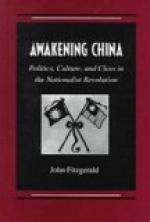In the absence of any explanation it may be concluded that during the suspension of hostilities negotiations were proceeding which resulted not in the destruction of the natives, but in their incorporation with their more civilised neighbours. This first recorded amalgamation of the kind was doubtless an instance of a process of growth that continued for many centuries, resulting in the absorption of all the native tribes on the north of the Yang-tse and of most of those on the south. The expanding state was eventually composed of a vast body of natives who submitted [Page 69] to their civilised conquerors, much as the people of Mexico and Peru consented to be ruled by a handful of Spaniards.[*]
[Footnote *: To this day, the bulk of the people in those countries show but small traces of Spanish blood. Juarez, the famous dictator, was a pure Indian.]
As late as the Christian era any authentic account of permanent conquests in China to the south of the “Great River” is still wanting, though warlike expeditions in that direction were not infrequent. The people of the northern provinces called themselves Han-jin, “men of Han” or “sons of Han,” while those of the south styled themselves T’ang-jin, “men of T’ang.” Does not this indicate that, while the former were moulded into unity by the great dynasty which took its name from the river Han (206 B. c.), the latter did not become Chinese until the brilliant period of the T’angs, nearly a thousand years later? Further confirmation need not be adduced to show that the empire of the Far East contemporary with, and superior in civilisation to, ancient Rome, embraced less than the eighteen provinces of China Proper. Of the nine districts into which it was divided by Ta-yue, 2100 B. C. not one was south of the “Great River.”
[Page 70] CHAPTER XIV
THE MYTHICAL PERIOD
Account of Creation—P’an-ku, the Ancient Founder—The Three Sovereigns—The Five Rulers, the Beginnings of Human Civilisation—The Golden Age—Yau, the Unselfish Monarch—Shun, the Paragon of Domestic Virtues—Story of Ta-yue—Rise of Hereditary Monarchy
Unlike the Greeks and Hindoos, the Chinese are deficient in the sort of imagination that breeds a poetical mythology. They are not, however, wanting in that pride of race which is prone to lay claim to the past as well as to the future. They have accordingly constructed, not a mythology, but a fictitious history which begins with the creation of the world.
How men and animals were made they do not say; but they assert that heaven and earth were united in a state of chaos until a divine man, whom they call P’an-ku, the “ancient founder,” rent them asunder. Pictures show him wielding his sledge-hammer and disengaging sun and moon from overlying hills—a grotesque conception in strong contrast with the simple and sublime statement, “God




